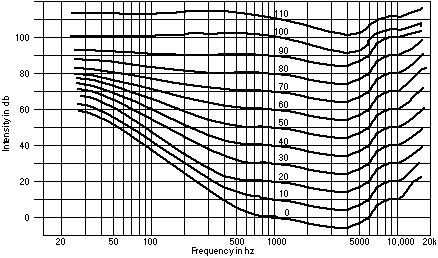Terminology & Concepts
Terminology & Concepts
Contents
- 1 Backline Amplifiers
- 2 Comb Filtering
- 3 Crossover
- 4 DI (box)
- 5 Dual Mono
- 6 Equal Loudness Curves
- 7 Fletcher Munson Curves
- 8 Gain Before Feedback
- 9 Inverse Square Law
- 10 Localization, Spaciousness and Reverberation
- 11 Nulls
- 12 Out of Phase (for Drum mics)
- 13 Phase (cancellation, interference)
- 14 Presets
- 15 Processors
- 16 Proximity Effect
- 17
- 18
Backline Amplifiers
Template:Instruments/Backline Amplifiers
Comb Filtering
Comb filtering occurs when two identical (or nearly identical) signals, one delayed in time relative to the other, are added. Depending on the delay time, the resulting summed signal can sound hollow or “boingy”, and is usually considered an undesirable sound.. Comb filtering occurs most commonly when signals are combined electronically, such as in a hard disc based recording system, but can also occur acoustically, such as a talker located slightly off axis of two identical microphones spaces inches apart.
(Thanks to Ken-at-Bose for this information).
See Nulls and [[Template:PageName#Phase]] below.
Crossover
See Crossover
DI (box)
Use a DI when you want to connect two devices and you have any of these issues:
- impedance mismatch
- line level mismatch
- differences in wiring or connectors (e.g. Balanced XLR to Unbalanced 1/4" Tip-Sleeve)
- noise - especially "hum" (ground loop)
A DI unit or DI box is an electronic device designed for connecting a piece of equipment with an electronic audio output to a standard microphone or line level input. It performs both level and impedance matching to minimise both noise and distortion. DI is variously claimed to stand for direct input, direct injection or direct interface. DI units are extensively used with professional and semi-professional PA systems and in sound recording studios. -- Wikipedia
You will also see the term DI used to refer to devices used to modify the tone as well as other properties of a signal. This is often in the context of Acoustic Guitar and Electric Bass. In the picture above the first two are passive DIs used for solving problems. The others are all sold as DIs that also shape the sound.
Dual Mono
This is amplifying the same sound source through two separate loudspeakers.
- Stereo vs. Mono in a Live Setting]
- Dual mono is usually not a good idea
- Can I use it as a PA? (Cliff-at-Bose talks about Dual Mono)
Equal Loudness Curves
(also known as Fletcher Munson curves)
"You will see lots of references to equal loudness curves or equal loudness contours- these are based on the work of Fletcher and Munson at Bell labs in the 30s, or perhaps refinements made more recently by Robinson and Dadson. These were made by asking people to judge when pure tones of two different frequencies were the same loudness. This is a very difficult judgment to make, and the curves are the average results from many subjects, so they should be considered general indicators rather than a prescription as to what a single individual might hear" - Numbers and Initials of Acoustics
See also:
http://www.sfu.ca/sonic-studio/handbook/Equal_Loudness_Contours.html
http://hyperphysics.phy-astr.gsu.edu/hbase/sound/eqloud.html
Fletcher Munson Curves
See Equal Loudness Curve above
Gain Before Feedback
Gain before feedback refers to the maximum sound pressure level that can be attained before the sound from a speaker enters the microphone and is amplified a second time, creating a loop that only builds on itself: feedback.
An often not very scientific measure of how loud a sound reinforcement system can be turned up before any open microphone(s) will feed back. The point at which feedback occurs is effected by numerous variables, including atmospheric conditions (temperature, humidity, etc.) so it's not something that anyone considers an objective measure of performance. Instead the phrase is used to state relative differences: "By adjusting the EQ I was able to get 'more' gain before feedback." -- Sweetwater
Inverse Square Law
Localization, Spaciousness and Reverberation
Nulls
Out of Phase (for Drum mics)
See Drums
Phase (cancellation, interference)
See Phase
Phase cancellation occurs when two signals of the same frequency are out of phase with each other resulting in either a boost or cut in the overall level of the combined signal. -- Phase at the Zen Audio Project
If you are suffering from some or all of these, you could be experiencing Phase Interference
- "Hot" and "cold" spots in the audience area
- Tonal coloration
- Poor speech intelligibility
- Lack of music clarity
- Poor gain-before-feedback
- Poor imaging
See: Practical Realities of Phase Interference
